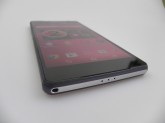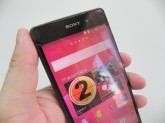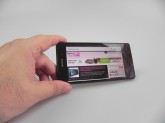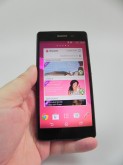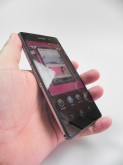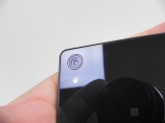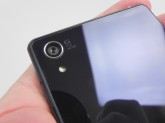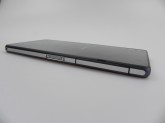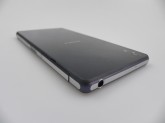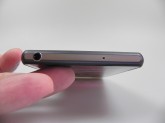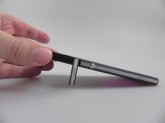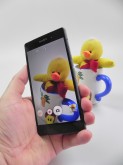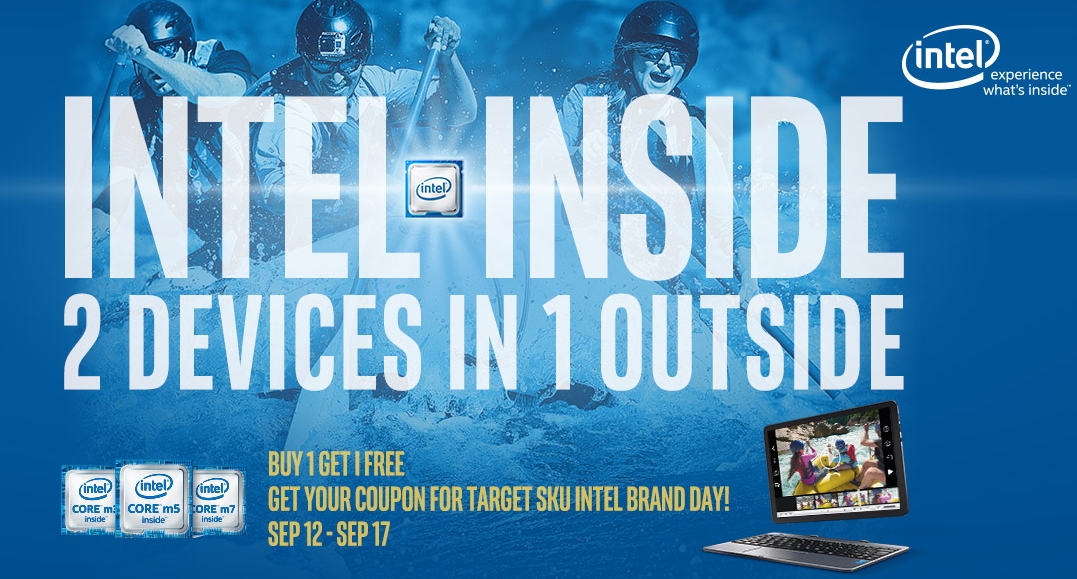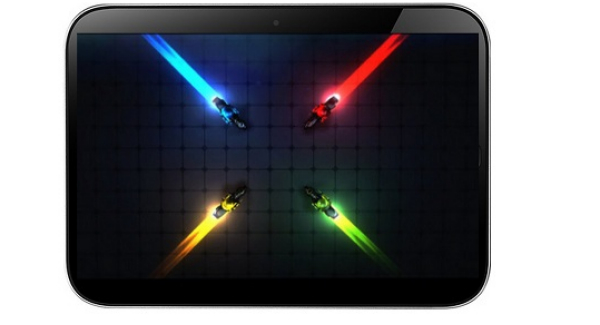A few months ago we reviewed the Sony Xperia Z1 and the Z1 Compact and while the first one disappointed us, the second one was pretty good. Now the Xperia Z2 comes and wants to solve all the problems of the Xperia Z1 and it does, it really, really does. Now let’s see how the device handles our tests, in the fully detailed review below.
This waterproof cameraphone was unveiled at MWC 2014 and it’s priced at 600 euros in the EU. This is a flagship launched a mere half a year after the Z1, so it’s launched very fast. The design involves an 8.2 mm, so it’s pretty thick by today’s standards, but for a 5.2 inch diagonal it’s OK. We also get a weight of 163 grams and the same general design format with Omnibalance approach. This model is a fingerprint and grease magnet, just like the predecessors.
This model is lighter than the Xperia Z1, but at the same time it’s 18 grams heavier than the Galaxy S5. The Xperia Z2 is a waterproof and dust proof device, with lids on ports, that protect it from water. This model has a rectangular design and adopts a glass front and back, plus an aluminum band on edges. You can submerge the product in water with a depth of about 1.5 metres and up to 30 minutes. You can also take pics underwater by the way.
Sony Xperia Z2 has now a slimmer bezel than its predecessor and it offers a better grip, thanks to its sides’ texture. At the top of the device we find the audio jack and microphone, while at the bottom there are 3 holes, that I associate with microphones, but I could be wrong so feel free to correct me. Also at the bottom, in the corner there’s a lanyard hole. On the right side of the smartphone we find a microSD card slot and On/Off button, with its typical metallic design for Xperias. There’s also the volume buttons and camera button on the same side and all of them have improved feedback.
On the left side of the handset there’s a big flap, covering up the microSIM and microUSB port. Then there are the dock pins on the same side and at the back we find the camera and flash, plus on the front there’s notification LED hidden in the upper speaker. Sony has decided to integrated dual stereo speakers here, one at the top and one at the bottom. We’ve also got a front camera and I have to mention that this model is 0.3 mm thinner than the Xperia Z1.
The bad thing about this design is that this is the fourth device in the Z series with exactly the same design, like the Xperia Z, Z1 and Z1 Compact and I can surely find a few more models with the same look. By the way, the angular design may dig into your palm after long minutes of talk, so that’s not OK. Still, the materials are premium (glass and metal). Moving on to the hardware, the dislplay is a Triluminous IPS LCD with a diagonal of 5.2 inch and Full HD resolution. The CPU is a quad core Qualcomm Snapdragon 801, clocked at 2.3 GHz, with Krait 400 cores and the Adreno 330 GPU.
The RAM is 3 GB here and storage is 16 GB, of which 12 GB are available. There’s a microSD card slot available, with support for up to 128 GB and a 20.7 MP camera lays at the back, with a 1/2.3 inch sensor and F/2.0 lens. The camera does 4K video and the front cam is a 2 MP unit. On the connectivity side we’ve got NFC, HSPA+, LTE, Bluetooth 4.0, MHL, DLNA, Miracast, WiFi Direct, GPS, WiFi dual band, FM radio and stereo speakers. Finally, the list of specs is rounded up by an accelerometer, gyroscope, proximity sensor and compass, plus a Li-Ion 3000 mAh battery.
On paper, the battery provides 740 hours of standby functioning or 120 hours of music playback, while in our test, that involves HD video playback with WiFi on and brightness a 50% we achieved 11 hours and 3 minutes, which is about identical to the performance of the Galaxy S5, that got 11 hours and 4 minutes in the same test. The Xperia Z2 at least beats the HTC One M8, that only scores 10 hours and 15 minutes in this test. In the Settings area you’ll also find some special Power Saving modes like the Stamina mode, that will disable WiFi and mobile connectivity when the screen is off and restrict hardware performance.
You can also add apps to a standby list and then there’s the Low Battery mode, allowing you to choose the features that can be turned off, stuff like GPS, vibrate and auto sync. Location based WiFi is also in the same battery saving area. Overall, the battery is good, especially when compared to the Xperia Z1, that only gave us 7 hours of playback. Its charging takes quite a while, about 3 hours.
Moving further to the acoustics, this is an area where expectations are high, because Sony finally moved to a dual stereo speaker setup. The Walkman app has been slightly revamped in the UI department, but not very much. It’s better organized now, but keeps the same features and options, stuff like ClearAudio+, that automatically optimizes the acoustics for the best playback experience.
We’ve got enhancements, that make out an equalizer, organized by genre or customized. Surround Sound is also an option, plus Clear Stereo that reduces crosstalk in headphones and Clear Phase, that adjusts the sound quality of the speaker. xLoud will increase the strength of the audio in the speaker and a brand new option is the S Force Front Surround, that brings surround to the speakers as well. Finally, we’ve got a dynamic normalizer, that makes all songs have the same level of volume. The speakers on the Z2 are about as loud as the ones on the Galaxy S5, but obviously less loud than the HTC One M8.
The sound is clear and crisp and the evolution is huge from the Xperia Z1. The headphones are a bit uncomfortable and they stick out of your ears too much, also going in too deep. They do offer the best bass I’ve ever heard on a mobile phone EVER. Their volume is also very high. Overall the audio is good, fit for a flagship and we’ve also got the FM radio experience, complete with Track ID and speaker output.
We also analyzed the display, a 5.2 inch Triluminous LCD that comes after a poor Z1 screen, that everybody criticized. We’ve got RGB stripe pixels, very vivid colors, wide view angles and the white-ish hue of the Z1 is finally gone. The brightness is pretty good and the display behaves well in sunlight. We used our luxmeter and got 366 lux units with this screen, which is about 100 units less than the Galaxy S5, HTC One M8 and Xperia Z1 Compact. Still, you can’t feel this difference, since the games and videos look perfect on this screen. I would say it’s bright enough and we’ve also got those extra settings like X Reality to enhance pics and videos and Glove Mode, to do some glove input.
You can adjust white balance and the red, green and blue hues. There’s also a Smart Backlight option, that keeps the screen on when you hold the device in your hand, plus a Font size option and double tap to wake up. This is a big improvement from the Z1, but still not exactly on par with the Galaxy S5. And now, on to the camera! The Sony Xperia Z2 features a 20.7 megapixel camera with a 1/2.3 inch sensor, with an F/2.0 lens and 27 mm focal length. There’s also a LED flash in the mix, 4K video capture and basically this is the Xperia Z1 camera with slight upgrades, but in fact it’s a bit more.
We’ve got digital stabilization, there’s no OIS here and this model can capture more light than the HTC One M8 and the Samsung Galaxy S5. The UI is pretty much the same as the one of the Xperia Z1 and Z1 Compact, with options on the left side and modes on the right. The viewfinder has a very good frame rate, just like in the case of the predecessor models. The modes include Superior Auto, that takes care of everything and optimizes every setting so the user customization is minimal and pictures look their best.
The detection of various situations is very good, I have to say. You can pick manual mode, if you like to choose your own options and settings. The Scenes are offered in a huge number, including night with a few options, pets, gourmet and many more, but they require 8 MP shots not 20 MP ones. You can also tweak the exposure, white balance, 5 flash options and the resolution. You start at 5248 x 3936, which is 20.7 MP in 4:3 and go to 15.5 MP in 16:9 and the others. HDR is also done at 8 MP and we’ve got options like self timer and smile shutter. Focus options include single, multi, face detection, touch and object tracking.
ISO goes up to 3200 and metering options include center, average and spot. Image stabilization is also an option and video manual settings are also available, like scenes, exposure, white balance, flash and Full HD 30 or 60 FPS options. HDR video and Steady Shot round up the video manual settings. Touch zoom is still too sensitive, so you’d better use the volume buttons. Moving on to the other Modes, there’s 4K video capture, Time Shift Video, that’s basically a way to make slow mo vids. Just like the iPhone 5s, you can create 120 FPS videos and choose what area of the vid to slow down.
Then there’s the new Background Defocus, an answer to the HTC One M8 Defocus and the Samsung Galaxy S5 Selective Focus. Background defocus from the Xperia Z2, allows you to take pics and change focus after taking them from the foreground to the background. You can choose the pattern of background blur and areas to cover it. I have to say I’m not very impressive by this feature, but at least it works compared to the Galaxy S5 Selective Focus, that we couldn’t get to work.
Back to the Modes, we’ve got AR Effect, that allows you to put dinosaurs on streets and masks on the faces of people. Creative Effect is also an option, filled with filters and sub filters, ranging from fisheye to hue, contrast, mirror, kaleidoscope and more. Then we’ve got Vine, Info Eye and TimeShift, all of them known from previous Xperias. Social Life and Sweep Panorama end the list, plus we installed Motiongraph and Motion Shot, that allow you to create GIFs and leave trails behind moving parts in pictures or videos. If you take a picture you’ll notice that the level of detail of the 20 MP shot is great.
I took all the pictures in the gallery on a cloudy day, so keep that in mind when judging the images. This is a total evolution from the Z1 and colors are vivid and realistic. Exposure is excellent, defocus works decently and the panorama is less wide than I expected. Macros look excellent, the dinosaur effects are still funny and the levels of detail are excellent. Indoor shots actually include a full gallery from a launch event for the Google Glass and those pictures also look fantastic and they’re very detailed.
The night shots play a huge part in the review’s high grade. The Sony Xperia Z2 takes fantastic night shots and they are the least yellowish ever, including all the other Android phones I’ve tested and even some Lumias. Colors are good, details are great and this is actually on par with the Lumia 1020. The night vid loses focus a bit and it’s much brighter and clearer than similar pictures and videos taken with the HTC One M8 and Samsung Galaxy S5.
Moving on to daylight videos, we’ve got 4K capture, 60 FPS that looks extremely realistic, slow mo that works fine and every video has good focus, good details even when zooming in and good colors and exposure. The Z2 is actually close to the Nokia Lumia Pureviews, which is a compliment. You can use no less than 4 options to edit pics: Photo Editor, the one from Sony, Photos from Google+, Pixlr Express and Sketch. Video Edit is also available, but only in order to trim videos and adjust the speed.
OK, so we’re done with the camera and I have to say this is the best cameraphone of 2014 I’ve tested so far. The temperature the smartphone reaches is about 41.5 degrees Celsius, so the overheating is less present than the 46 degrees of the Xperia Z1. And now the benchmarks! I compared this model to the HTC One M8 and the Samsung Galaxy S5 in 10 tests. In Quadrant, the Xperia Z2 got 17k points, below the 24k of the HTC One M8 or the 22k of the Galaxy S5. In AnTuTu we got 33k points, pretty close to the 34k of the rivals, while in NenaMark we were at 59.8 FPS with the z2, beating the HTC One M8 by 0.5 FPS, but scoring lower than the Galaxy S5 and its 60.1 FPS.
In Vellamo we had 1602 points, about 1000 less than the rivals, while in 3DMark the score was better, at 18k points, more than the HTC model and almost the same as the Galaxy S5. BrowserMark 2.0 had a decent score of 2884 for the Z2, higher than the HTC and lower than the Galaxy S, while Geek Bench 3 registered a 941/2748 score (single core/multi core). This is inferior compared to the M8 and superior compared to the S5. Finally, in GFXBenchmark we had the same score as the Galaxy S5, which is 27.4 FPS in the offscreen 1080p test. I also did a speed test and got 22 Mbps in download and 23 Mbps in upload, which I would call OK.
Sunspider also brought us a score of 1000 points, two times worse than the score of the Galaxy S5. Overall, the benchmarks are strangely low, but you can’t actually feel that in the day to day use. The web browser used here is Chrome and it’s not the fastest in the world, but it does its job, while the keyboard provided here is well spaced and comfy. In the phone call area we have a ton of options to play and a very crisp voice experience. Options include special noise canceling, mic noise suppression, an EQ, speaker voice enhance and even the option to slow down the person on the other end of the line.
Moving on to software, there’s Android 4.4.2 here with the usual Sony UI on top, this time more glossy than the competition, that has gone flat. Pinching the homescreens brings you to an area with widgets, apps, wallpapers and themes and those haven’t change much as well. The UI is sleek but I feel that it’s been the same for about 2 years now. The notification and quick settings area look predictable, but they work fine and in the Settings area you can find some Xperia/Dual Shock related options, that will allow you to connect your PS3 joystick to your handset.
If you press the multitasking button, you’ll not only trigger the usual list of apps, but also a smaller list of applications, available as on screen floating apps used at the same time. We’ve also got a huge list of preinstalled applications, most of them feeling like bloatware. They include a Whats New app from Sony, featuring the latest in themes, apps and such thing, plus Sony Select, that recommends some of the apps and games you may like on your device. We’ve got Social Life as a Flipboard alternative, that includes both news and social networking feeds.
Other apps include Track ID, Video Unlimited, Smart Connect, the usual Play Suite, PlayStation with PSN connection, Amazon Kindle, Track ID TV, Vine, Office Suite, Trip Advisor, File Commander and eBay. There’s Sketch, Pixlr Express, PlayStation Mobile and finally Garmin, that didn’t exactly work perfectly. And now the Pros and Cons of the device.
Here are the Pros:
- improved screen from Xperia Z1
- lighter than you’d expect
- good battery – 11 hours
- good stereo speakers
- excellent camera
- night capture is great
- great video capture
- lots of voice call options
- better grip
- waterproof and dust proof
- 3 GB of RAM
And here are the Cons:
- low benchmarks
- same design format for about 2 years
- same UI for 2 years
- could be brighter
- big headphones coming out of the ears
- a bit of overheating
- lots of bloatware
Sony Xperia Z2 gets a 9.2 out of 10 for design, 9.6 out of 10 for hardware and 9.5 out of 10 for OS and UI. The smartphone gets from us a 9.43 out of 10 and it’s the best Android cameraphone I’ve tested this year. It’s also a major upgrade from the Z1, that was a letdown.
[youtube qlDBbbrGi3Q 660 520]
Post Footer automatically generated by Add Post Footer Plugin for wordpress.















